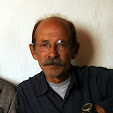
The first of the winter rains had come to southeastern Turkey in early November. There was a low ceiling of gray clouds and the wind was biting. “That used to be my house,” Ibrahim said pointing to a crumbling of tan stone down the slope. I stood on the hillside with he and Fathel (actual names not used) looking over the rocky landscape mutely adorned by the remains of a Yezidi Kurd village. With effort I imagined the village with a thousand inhabitants 25 years ago.
The Yezidi Kurds of this and virtually all Yezidian villages left Turkey in the 1980s during the early years of the Separatist War in eastern Turkey (1984-1999) that pitted Kurdish military guerrilla forces against the steroidal Turkish military. The war was an inevitable outcome of 50 years of State-sponsored spherical oppression of the Kurds. A central feature of Turkey's military strategy during the war was to destroy and empty Kurdish villages (Muslim and Yezidi alike) to deny the PKK (Kurdish Workers Party) guerrillas support, whether such support was voluntary or coerced.
“And over there,” Fathel said, “is the school bombed by the "asker" (Turkish soldiers).” Even its once-white concrete walls were turning tan, disappearing into the landscape. The Yezidis had been granted political asylum principally by Germany and Belgium, and so they went. They had little choice Ibrahim said, drawing his finger across his throat.
They had returned from Europe to their village for a 2-month visit, as a few others have intermittently done as well. Two others had built new “summer homes” in the village, not willing to give up their past entirely, but not at the expense of their new found security. “In Belgium nobody cares if you are Yezidi,” Ibrahim said, still with a hint of wonder.
The Yezidis are an ultra-minority within the Kurdish family, itself a minority in the greater Middle East. It was this double whammy that convicted the Yezidians in Turkey to a near-complete diaspora in the matter of a few years.
There are many such vacant and crumbling Kurdish Yezidian villages in southeastern Turkey, another chapter in the their millennia-long history; in fact in the broader Kurdish history as well. Yezidi'ism is an ancient religion, believed by many to be a direct descendant of Zorastrianism, by others to predate it, and by a few to be an apostate offspring of Islam. Regardless of its longevity, its adherents have been routinely persecuted by Muslims – Arab, Turkic, and Kurdish alike - as Yezidis are not even afforded the shell of Qoranic legitimacy granted to Jews and Christians.

We walked over the sticky blood red soil that filled the spaces between the limestone bedrock, towards a modest mazar (Yezidi shrine or temple) named after the sun, roj. It looked tired and lonely sitting on another hilltop surrounded by a rock wall, kept company only by two mulberry trees, one bedecked by few swatches of cloth bearing wishes. “It is like Lalish [the Yezidi holy site in Iraqi Kurdistan],” Ibrahim said, knowing that it really wasn't true. It was a small mazar with a tented crown topped by a stubby spire. The Yezidi stone inscription above the 3-foot high locked door had been chiseled away by the Muslims he said. He didn't say "asker."
Ibrahim now owned a herd of 25 cows, and in an ironic twist of fate, hired a Muslim Kurd to tend to them. It was dusk when the shepherd walked the cows back from the day at pasture. We hurried to help corral them into their night quarters. From the outside it looked like a small stone house built into the hillside, but its back end was a cave that bore its way deep into the hillside. It was very dark inside.




No comments:
Post a Comment